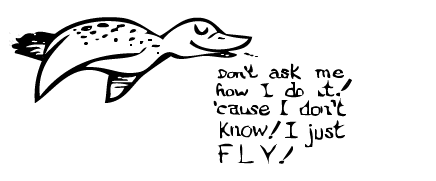What does it mean to “Fly the Wing” ?
 James was reading a flight training manual that mentions “Flying the Wing” so he writes to ask:
James was reading a flight training manual that mentions “Flying the Wing” so he writes to ask:
I am in the early stages of learning the art of flying, what exactly does flying the wing mean/entail? Thank-You.
The term “Fly the Wing” (as I understand it) refers to the practice of controlling the airplane with emphasis being placed on the aircraft’s AOA (angle-of-attack) and attitude.
While trying to think of a good way to describe this term, I came across an older book in my library entitled, “Safe for Solo – What Every Young Aviator Should Know” This book was written by Frederick M. Reeder and illustrated by my new favorite aviation artist, Robert C. Osborn. There are several wonderful chapters in this book and they describe wonderfully what “flying the wing” is all about.
The definition of “Flying the Wing” from “Safe for Solo” after the break.
From chapter 12, “What the controls do and how to use them”:
Naturally the next question may logically be, “Just how much do I pull back on the stick to climb at a ten-degree angle?” The answer is that you just don’t fly a plane that way. What you are concerned with is the attitude of the plane. You decide what attitude you want to put the plane in, and then you give it whatever control is necessary to make it assume that attitude. The amount of control will vary with the attitude and speed of the plane and must be applied in quantities dictated by the way your plane looks and feels.
In using the controls you must focus your attention outside of the cockpit rather than within.
Chapter 14, “Attitude”:
The dictionary says that attitude can be either a state of mind or a position of the body. The state of mind of a flier is important as regards his flying, but when you mention the word “attitude” to an aviator, it is generally taken for granted that you mean the position of an airplane in relation to the earth.

You have three means of estimating your attitude. The one you use most is your sight. You look at the position of your nose and wings and compare them with the horizon. You also use your vision to determine whether or not the nose is moving in respect to the earth. The next most important help is your feel. When you have a little more experience in the air you will be able to use feel to help you determine your attitude. In addition, as a minor aid in determining attitude, you have the sound of the your plane. Sound is not so much help, especially if you are flying a closed plane. However, if you are in a climb or a dive, your plane will sound differently from the way it does in level flight. The pitch increases and the noise becomes higher when you are going faster.
In flying you use all three of these senses simultaneously to help you estimate the attitude of your plane.

I really can’t think of any better description of what it means to “Fly the Wing”. It means focusing on aircraft control with reference to attitude and angle-of-attack. Look outside and fly the damn airplane.
For most pilots their first experience with “flying the wing” happens quite accidentally. If you have ever taken off with a frozen pitot tube (which results in a frozen airspeed indicator) then you have experienced what is means to “fly the wing”. You stop focusing on flight instruments and focus on the plane’s attitude by looking OUTSIDE. Suddenly without reference to airspeed, the aircraft’s attitude becomes primary. You want to climb, you pull up. You want to level off, you decrease the wing’s AOA and maintain a level flight attitude.
In closing:
…Flying is easy, but if you overanalyze your control-movements and clog up your thought process you can make it tough.
Fly Safe!

